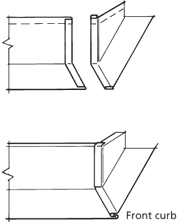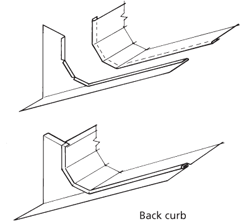Penetrations
Penetration flashings used in conjunction with fully supported metal roof cladding require specialist detailing. The details for weathering penetrations in fully supported roof cladding that are included in this section should be read in conjunction with section 8.0. penetrations.
The back curb of the flashing upslope from the penetration should be installed under the roof panels, and the front apron of the flashing should be installed over the roof panels.
The designer is responsible for coordinating the penetration location to be sure that a penetration will not coincide with the panel seams.
When the penetration is less than 50% of the width of a panel, the hole can be weathered by using a fabricated flashing made by forming an upstand by soldering, welding or sealing.
Large penetrations are more complex and require additional considerations during design and installation.
Regardless of the penetration size, weatherproofing should be achieved without relying solely on sealant and independent movement of panel and penetration should be allowed for.
When the penetration width is over 600 mm the panel ribs should be stopped short of the upslope face of the curb, so that water can flow past the ends of the ribs and not be trapped against the curb.
Large penetrations that require flashing through the panel ribs and are over 600 mm wide should be factory manufactured to a cricket design as described in section 15.8.
- Log in to post comments


